Taxation Law Assignment - University Name, Semester 1, 2024
VerifiedAdded on 2020/04/07
|10
|2754
|243
Homework Assignment
AI Summary
This Taxation Law assignment solution addresses several tax-related scenarios. Question 1 examines the tax implications of capital gains from the sale of personal assets and collectibles, calculating net capital gains or losses. Question 2 analyzes the tax treatment of an incidental benefit, specifically a low-interest loan, determining the assessable amount. Question 3 explores the tax implications for a couple owning a rental property, considering the allocation of profits and losses. Question 4 discusses tax avoidance and the Westminster principle. Finally, Question 5 provides advice on the tax implications of income received from a logging company. The solution provides detailed analysis, supporting evidence, and conclusions for each question.
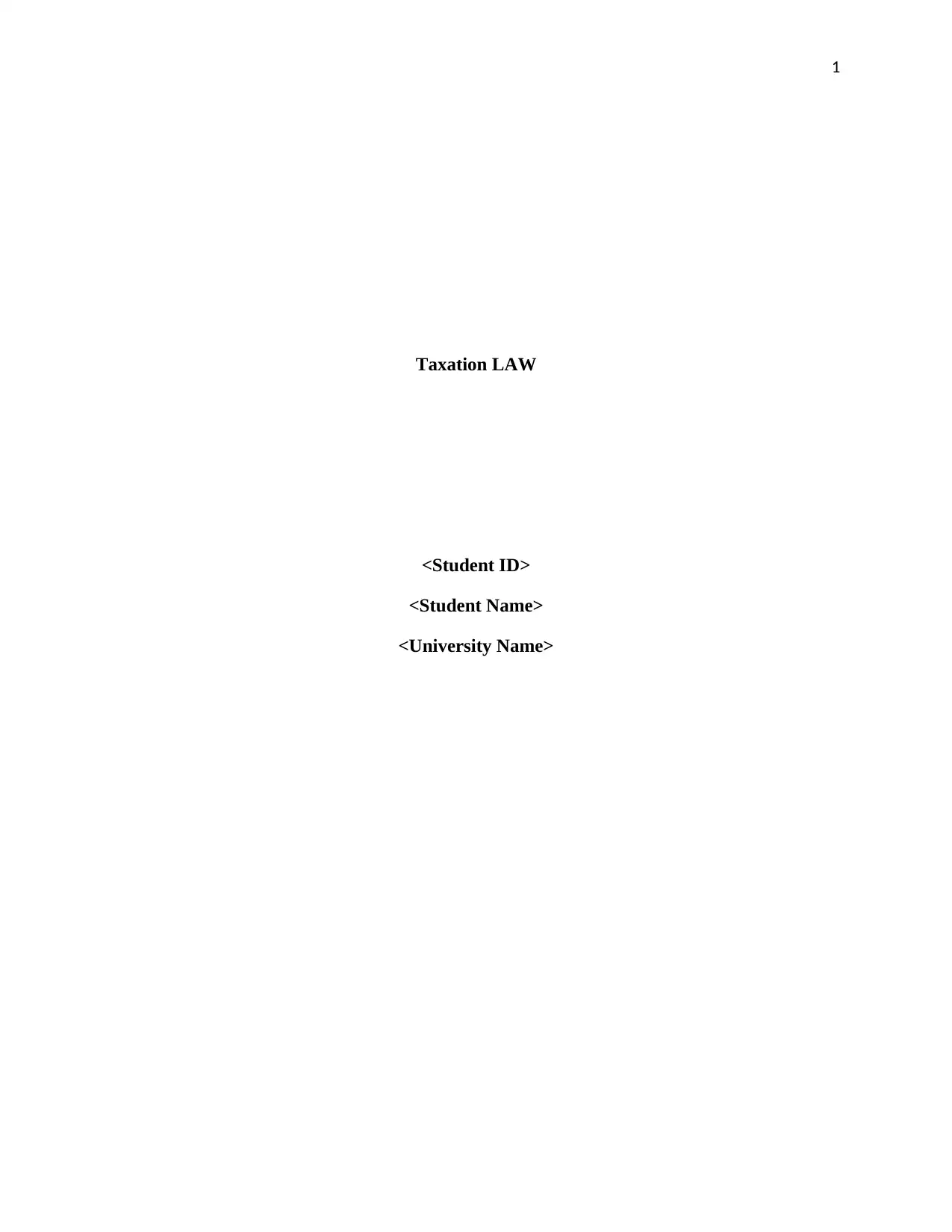
1
Taxation LAW
<Student ID>
<Student Name>
<University Name>
Taxation LAW
<Student ID>
<Student Name>
<University Name>
Paraphrase This Document
Need a fresh take? Get an instant paraphrase of this document with our AI Paraphraser
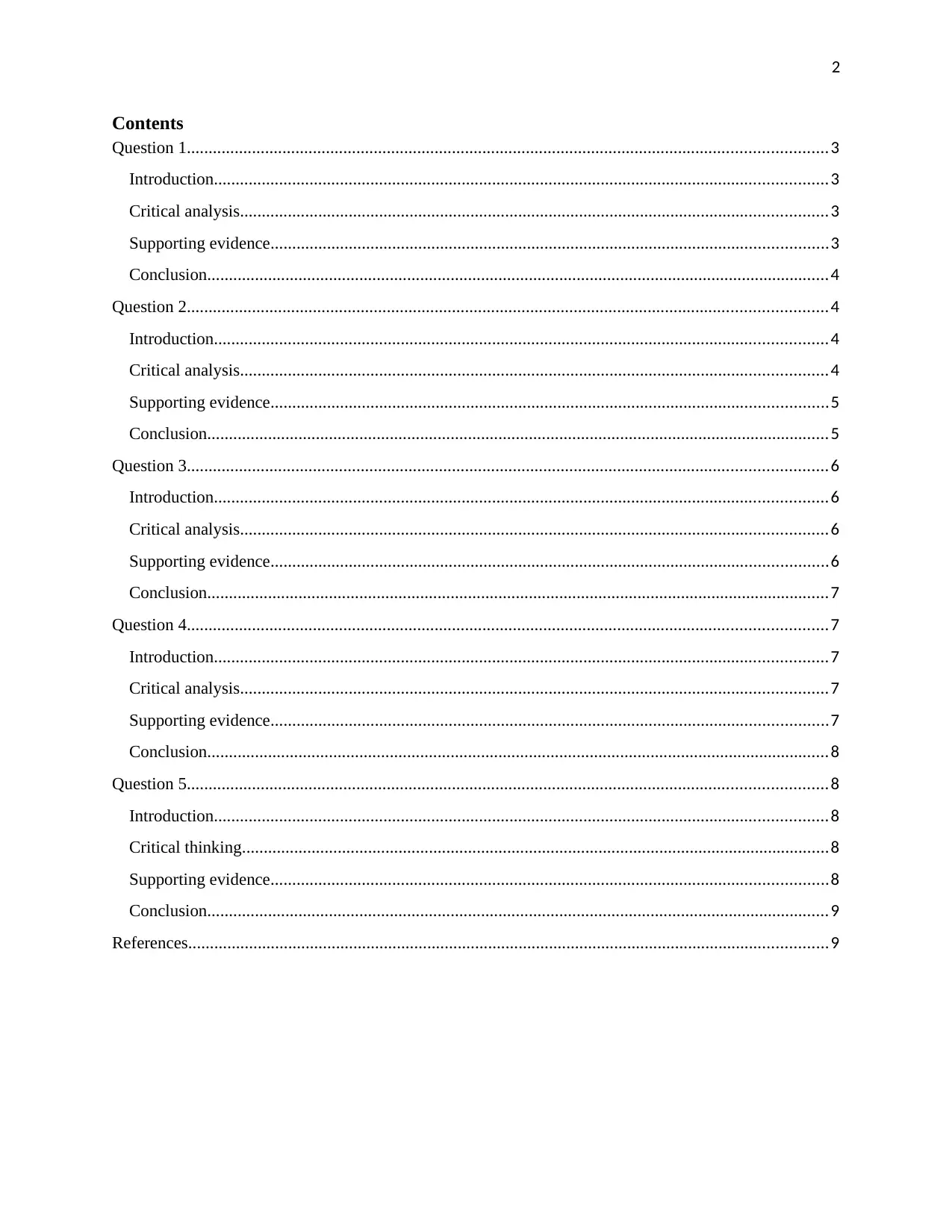
2
Contents
Question 1...................................................................................................................................................3
Introduction.............................................................................................................................................3
Critical analysis.......................................................................................................................................3
Supporting evidence................................................................................................................................3
Conclusion...............................................................................................................................................4
Question 2...................................................................................................................................................4
Introduction.............................................................................................................................................4
Critical analysis.......................................................................................................................................4
Supporting evidence................................................................................................................................5
Conclusion...............................................................................................................................................5
Question 3...................................................................................................................................................6
Introduction.............................................................................................................................................6
Critical analysis.......................................................................................................................................6
Supporting evidence................................................................................................................................6
Conclusion...............................................................................................................................................7
Question 4...................................................................................................................................................7
Introduction.............................................................................................................................................7
Critical analysis.......................................................................................................................................7
Supporting evidence................................................................................................................................7
Conclusion...............................................................................................................................................8
Question 5...................................................................................................................................................8
Introduction.............................................................................................................................................8
Critical thinking.......................................................................................................................................8
Supporting evidence................................................................................................................................8
Conclusion...............................................................................................................................................9
References...................................................................................................................................................9
Contents
Question 1...................................................................................................................................................3
Introduction.............................................................................................................................................3
Critical analysis.......................................................................................................................................3
Supporting evidence................................................................................................................................3
Conclusion...............................................................................................................................................4
Question 2...................................................................................................................................................4
Introduction.............................................................................................................................................4
Critical analysis.......................................................................................................................................4
Supporting evidence................................................................................................................................5
Conclusion...............................................................................................................................................5
Question 3...................................................................................................................................................6
Introduction.............................................................................................................................................6
Critical analysis.......................................................................................................................................6
Supporting evidence................................................................................................................................6
Conclusion...............................................................................................................................................7
Question 4...................................................................................................................................................7
Introduction.............................................................................................................................................7
Critical analysis.......................................................................................................................................7
Supporting evidence................................................................................................................................7
Conclusion...............................................................................................................................................8
Question 5...................................................................................................................................................8
Introduction.............................................................................................................................................8
Critical thinking.......................................................................................................................................8
Supporting evidence................................................................................................................................8
Conclusion...............................................................................................................................................9
References...................................................................................................................................................9
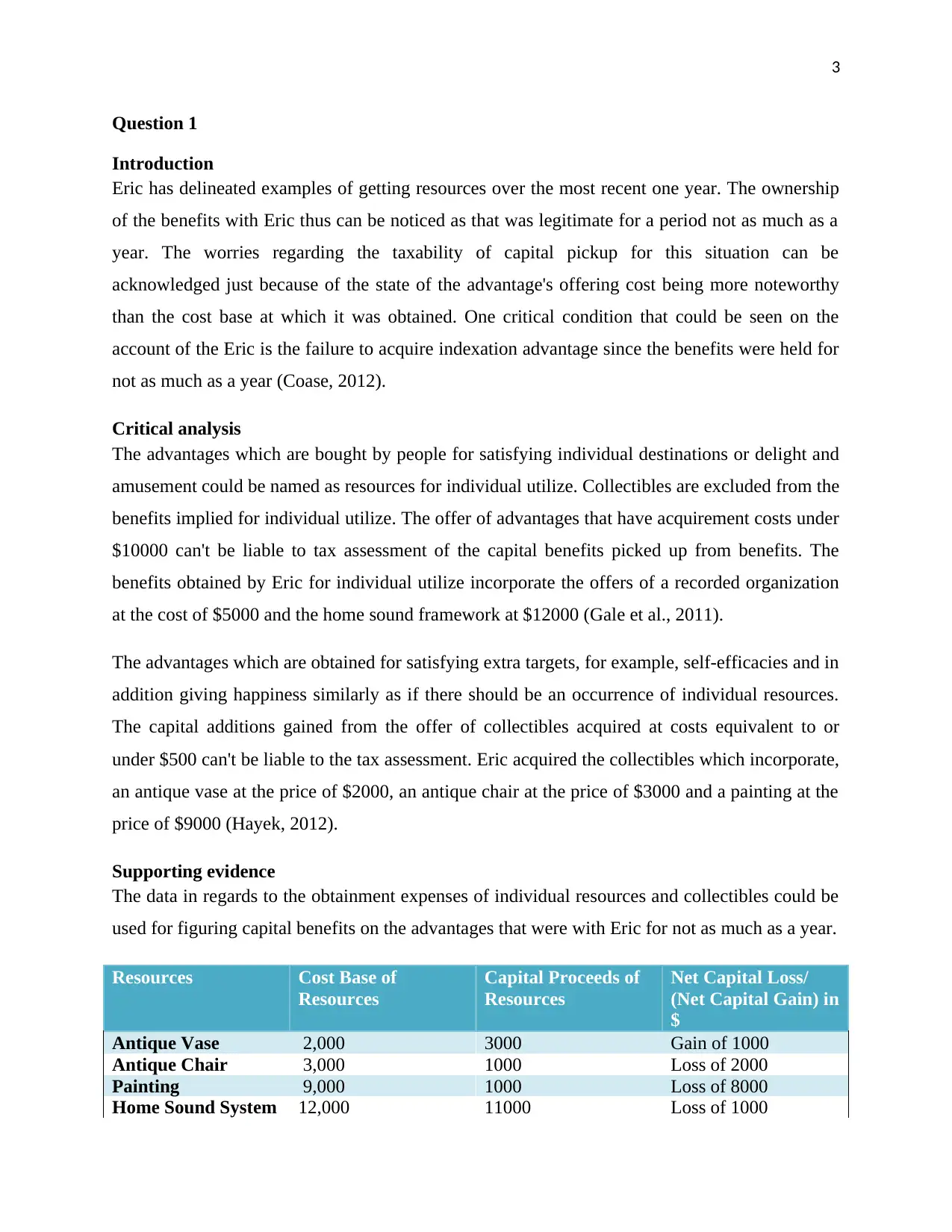
3
Question 1
Introduction
Eric has delineated examples of getting resources over the most recent one year. The ownership
of the benefits with Eric thus can be noticed as that was legitimate for a period not as much as a
year. The worries regarding the taxability of capital pickup for this situation can be
acknowledged just because of the state of the advantage's offering cost being more noteworthy
than the cost base at which it was obtained. One critical condition that could be seen on the
account of the Eric is the failure to acquire indexation advantage since the benefits were held for
not as much as a year (Coase, 2012).
Critical analysis
The advantages which are bought by people for satisfying individual destinations or delight and
amusement could be named as resources for individual utilize. Collectibles are excluded from the
benefits implied for individual utilize. The offer of advantages that have acquirement costs under
$10000 can't be liable to tax assessment of the capital benefits picked up from benefits. The
benefits obtained by Eric for individual utilize incorporate the offers of a recorded organization
at the cost of $5000 and the home sound framework at $12000 (Gale et al., 2011).
The advantages which are obtained for satisfying extra targets, for example, self-efficacies and in
addition giving happiness similarly as if there should be an occurrence of individual resources.
The capital additions gained from the offer of collectibles acquired at costs equivalent to or
under $500 can't be liable to the tax assessment. Eric acquired the collectibles which incorporate,
an antique vase at the price of $2000, an antique chair at the price of $3000 and a painting at the
price of $9000 (Hayek, 2012).
Supporting evidence
The data in regards to the obtainment expenses of individual resources and collectibles could be
used for figuring capital benefits on the advantages that were with Eric for not as much as a year.
Resources Cost Base of
Resources
Capital Proceeds of
Resources
Net Capital Loss/
(Net Capital Gain) in
$
Antique Vase 2,000 3000 Gain of 1000
Antique Chair 3,000 1000 Loss of 2000
Painting 9,000 1000 Loss of 8000
Home Sound System 12,000 11000 Loss of 1000
Question 1
Introduction
Eric has delineated examples of getting resources over the most recent one year. The ownership
of the benefits with Eric thus can be noticed as that was legitimate for a period not as much as a
year. The worries regarding the taxability of capital pickup for this situation can be
acknowledged just because of the state of the advantage's offering cost being more noteworthy
than the cost base at which it was obtained. One critical condition that could be seen on the
account of the Eric is the failure to acquire indexation advantage since the benefits were held for
not as much as a year (Coase, 2012).
Critical analysis
The advantages which are bought by people for satisfying individual destinations or delight and
amusement could be named as resources for individual utilize. Collectibles are excluded from the
benefits implied for individual utilize. The offer of advantages that have acquirement costs under
$10000 can't be liable to tax assessment of the capital benefits picked up from benefits. The
benefits obtained by Eric for individual utilize incorporate the offers of a recorded organization
at the cost of $5000 and the home sound framework at $12000 (Gale et al., 2011).
The advantages which are obtained for satisfying extra targets, for example, self-efficacies and in
addition giving happiness similarly as if there should be an occurrence of individual resources.
The capital additions gained from the offer of collectibles acquired at costs equivalent to or
under $500 can't be liable to the tax assessment. Eric acquired the collectibles which incorporate,
an antique vase at the price of $2000, an antique chair at the price of $3000 and a painting at the
price of $9000 (Hayek, 2012).
Supporting evidence
The data in regards to the obtainment expenses of individual resources and collectibles could be
used for figuring capital benefits on the advantages that were with Eric for not as much as a year.
Resources Cost Base of
Resources
Capital Proceeds of
Resources
Net Capital Loss/
(Net Capital Gain) in
$
Antique Vase 2,000 3000 Gain of 1000
Antique Chair 3,000 1000 Loss of 2000
Painting 9,000 1000 Loss of 8000
Home Sound System 12,000 11000 Loss of 1000
⊘ This is a preview!⊘
Do you want full access?
Subscribe today to unlock all pages.

Trusted by 1+ million students worldwide
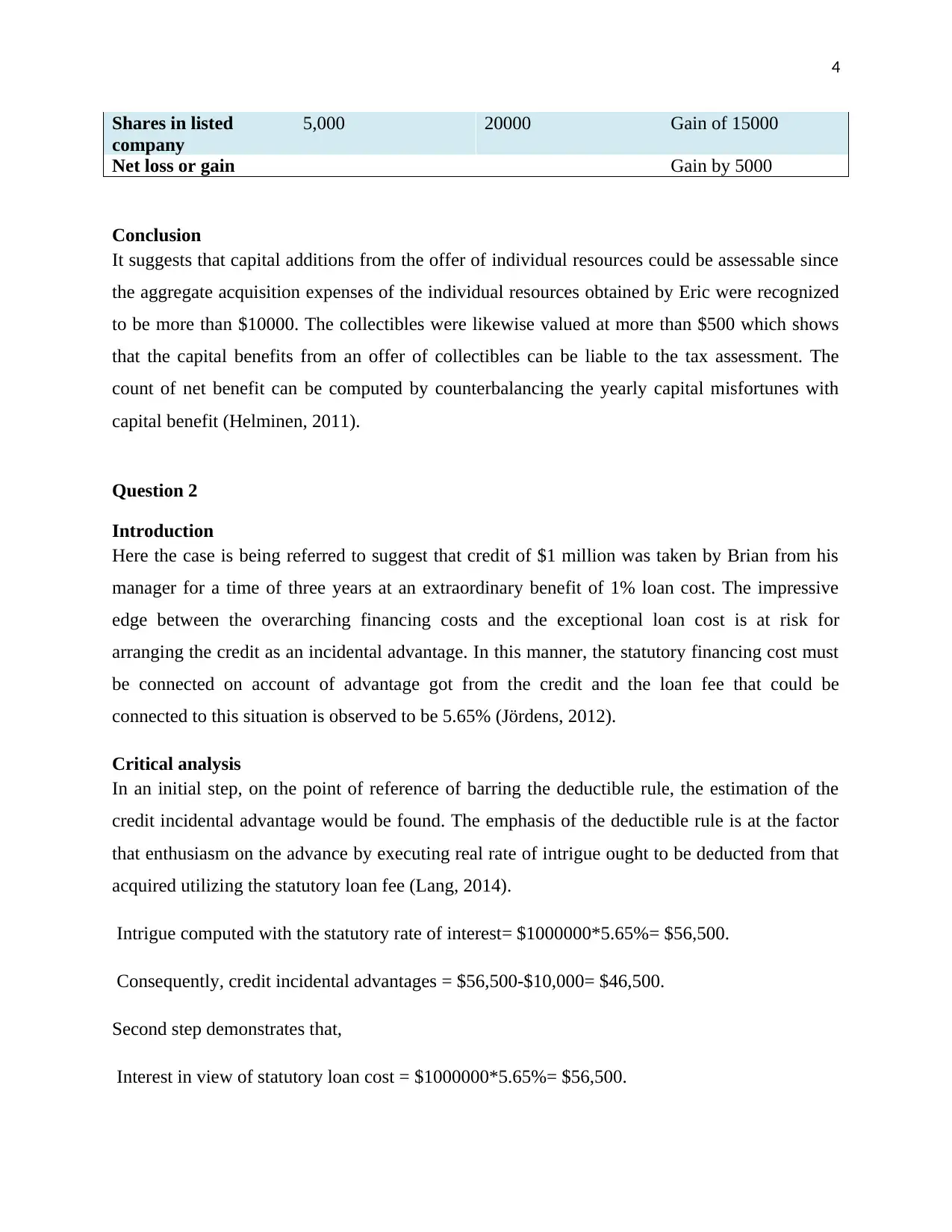
4
Shares in listed
company
5,000 20000 Gain of 15000
Net loss or gain Gain by 5000
Conclusion
It suggests that capital additions from the offer of individual resources could be assessable since
the aggregate acquisition expenses of the individual resources obtained by Eric were recognized
to be more than $10000. The collectibles were likewise valued at more than $500 which shows
that the capital benefits from an offer of collectibles can be liable to the tax assessment. The
count of net benefit can be computed by counterbalancing the yearly capital misfortunes with
capital benefit (Helminen, 2011).
Question 2
Introduction
Here the case is being referred to suggest that credit of $1 million was taken by Brian from his
manager for a time of three years at an extraordinary benefit of 1% loan cost. The impressive
edge between the overarching financing costs and the exceptional loan cost is at risk for
arranging the credit as an incidental advantage. In this manner, the statutory financing cost must
be connected on account of advantage got from the credit and the loan fee that could be
connected to this situation is observed to be 5.65% (Jördens, 2012).
Critical analysis
In an initial step, on the point of reference of barring the deductible rule, the estimation of the
credit incidental advantage would be found. The emphasis of the deductible rule is at the factor
that enthusiasm on the advance by executing real rate of intrigue ought to be deducted from that
acquired utilizing the statutory loan fee (Lang, 2014).
Intrigue computed with the statutory rate of interest= $1000000*5.65%= $56,500.
Consequently, credit incidental advantages = $56,500-$10,000= $46,500.
Second step demonstrates that,
Interest in view of statutory loan cost = $1000000*5.65%= $56,500.
Shares in listed
company
5,000 20000 Gain of 15000
Net loss or gain Gain by 5000
Conclusion
It suggests that capital additions from the offer of individual resources could be assessable since
the aggregate acquisition expenses of the individual resources obtained by Eric were recognized
to be more than $10000. The collectibles were likewise valued at more than $500 which shows
that the capital benefits from an offer of collectibles can be liable to the tax assessment. The
count of net benefit can be computed by counterbalancing the yearly capital misfortunes with
capital benefit (Helminen, 2011).
Question 2
Introduction
Here the case is being referred to suggest that credit of $1 million was taken by Brian from his
manager for a time of three years at an extraordinary benefit of 1% loan cost. The impressive
edge between the overarching financing costs and the exceptional loan cost is at risk for
arranging the credit as an incidental advantage. In this manner, the statutory financing cost must
be connected on account of advantage got from the credit and the loan fee that could be
connected to this situation is observed to be 5.65% (Jördens, 2012).
Critical analysis
In an initial step, on the point of reference of barring the deductible rule, the estimation of the
credit incidental advantage would be found. The emphasis of the deductible rule is at the factor
that enthusiasm on the advance by executing real rate of intrigue ought to be deducted from that
acquired utilizing the statutory loan fee (Lang, 2014).
Intrigue computed with the statutory rate of interest= $1000000*5.65%= $56,500.
Consequently, credit incidental advantages = $56,500-$10,000= $46,500.
Second step demonstrates that,
Interest in view of statutory loan cost = $1000000*5.65%= $56,500.
Paraphrase This Document
Need a fresh take? Get an instant paraphrase of this document with our AI Paraphraser
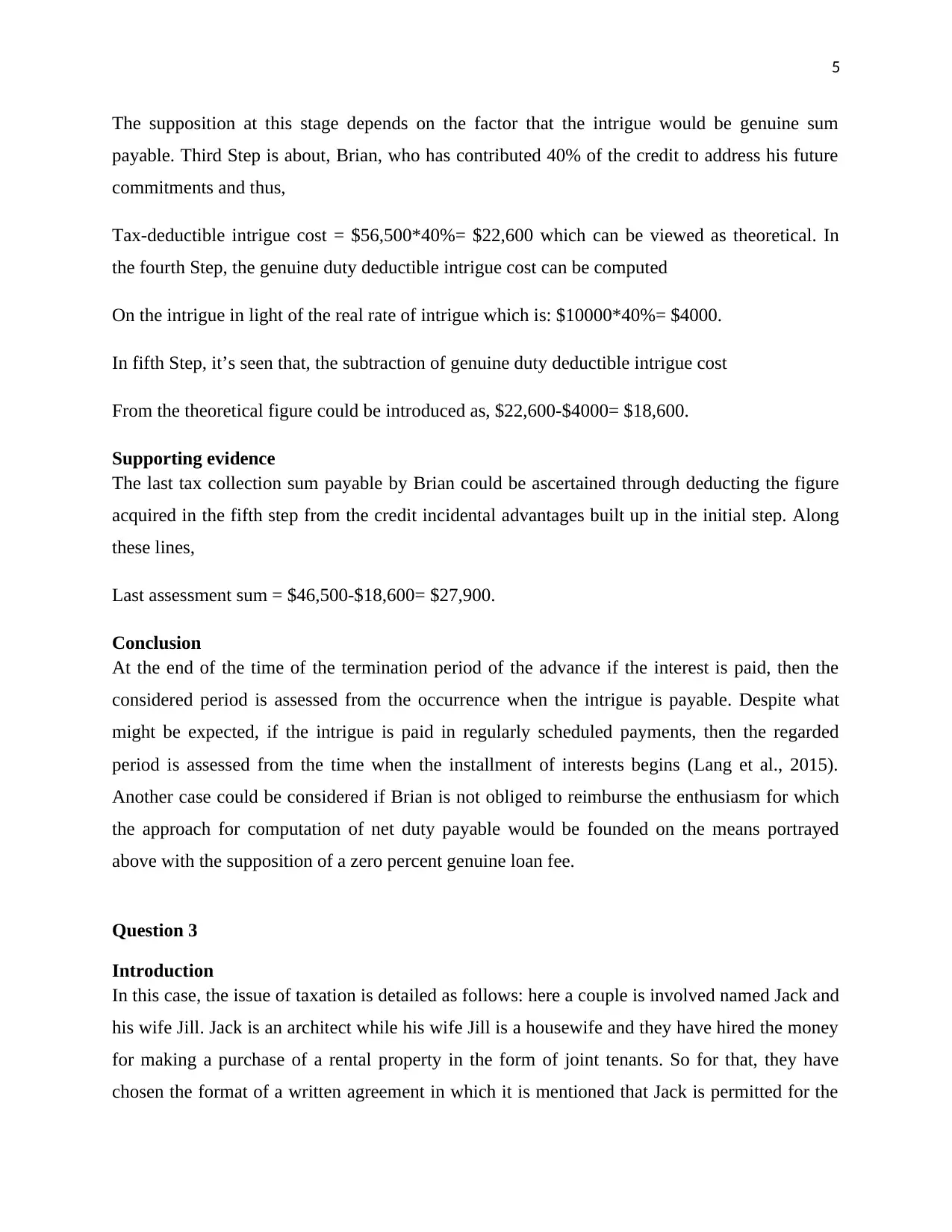
5
The supposition at this stage depends on the factor that the intrigue would be genuine sum
payable. Third Step is about, Brian, who has contributed 40% of the credit to address his future
commitments and thus,
Tax-deductible intrigue cost = $56,500*40%= $22,600 which can be viewed as theoretical. In
the fourth Step, the genuine duty deductible intrigue cost can be computed
On the intrigue in light of the real rate of intrigue which is: $10000*40%= $4000.
In fifth Step, it’s seen that, the subtraction of genuine duty deductible intrigue cost
From the theoretical figure could be introduced as, $22,600-$4000= $18,600.
Supporting evidence
The last tax collection sum payable by Brian could be ascertained through deducting the figure
acquired in the fifth step from the credit incidental advantages built up in the initial step. Along
these lines,
Last assessment sum = $46,500-$18,600= $27,900.
Conclusion
At the end of the time of the termination period of the advance if the interest is paid, then the
considered period is assessed from the occurrence when the intrigue is payable. Despite what
might be expected, if the intrigue is paid in regularly scheduled payments, then the regarded
period is assessed from the time when the installment of interests begins (Lang et al., 2015).
Another case could be considered if Brian is not obliged to reimburse the enthusiasm for which
the approach for computation of net duty payable would be founded on the means portrayed
above with the supposition of a zero percent genuine loan fee.
Question 3
Introduction
In this case, the issue of taxation is detailed as follows: here a couple is involved named Jack and
his wife Jill. Jack is an architect while his wife Jill is a housewife and they have hired the money
for making a purchase of a rental property in the form of joint tenants. So for that, they have
chosen the format of a written agreement in which it is mentioned that Jack is permitted for the
The supposition at this stage depends on the factor that the intrigue would be genuine sum
payable. Third Step is about, Brian, who has contributed 40% of the credit to address his future
commitments and thus,
Tax-deductible intrigue cost = $56,500*40%= $22,600 which can be viewed as theoretical. In
the fourth Step, the genuine duty deductible intrigue cost can be computed
On the intrigue in light of the real rate of intrigue which is: $10000*40%= $4000.
In fifth Step, it’s seen that, the subtraction of genuine duty deductible intrigue cost
From the theoretical figure could be introduced as, $22,600-$4000= $18,600.
Supporting evidence
The last tax collection sum payable by Brian could be ascertained through deducting the figure
acquired in the fifth step from the credit incidental advantages built up in the initial step. Along
these lines,
Last assessment sum = $46,500-$18,600= $27,900.
Conclusion
At the end of the time of the termination period of the advance if the interest is paid, then the
considered period is assessed from the occurrence when the intrigue is payable. Despite what
might be expected, if the intrigue is paid in regularly scheduled payments, then the regarded
period is assessed from the time when the installment of interests begins (Lang et al., 2015).
Another case could be considered if Brian is not obliged to reimburse the enthusiasm for which
the approach for computation of net duty payable would be founded on the means portrayed
above with the supposition of a zero percent genuine loan fee.
Question 3
Introduction
In this case, the issue of taxation is detailed as follows: here a couple is involved named Jack and
his wife Jill. Jack is an architect while his wife Jill is a housewife and they have hired the money
for making a purchase of a rental property in the form of joint tenants. So for that, they have
chosen the format of a written agreement in which it is mentioned that Jack is permitted for the
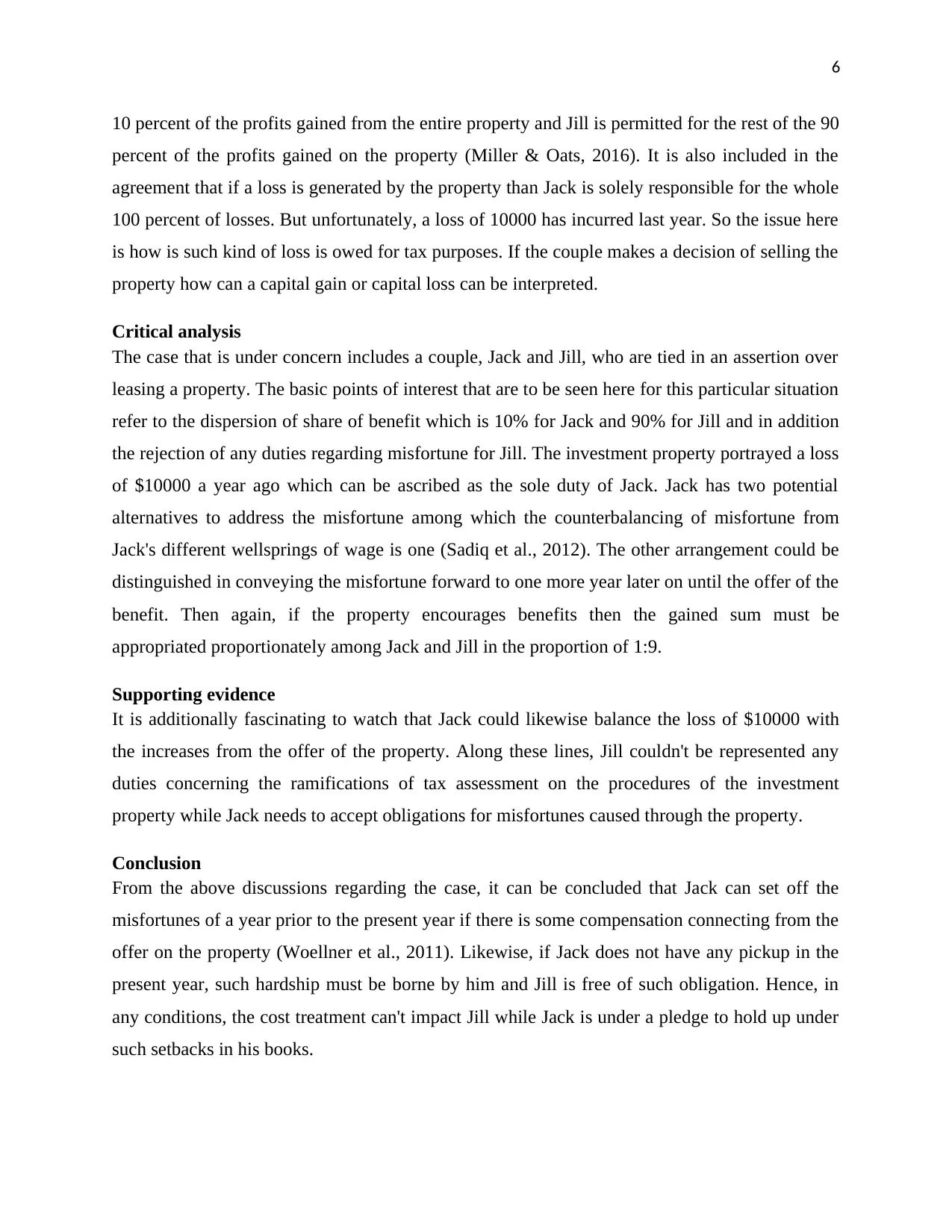
6
10 percent of the profits gained from the entire property and Jill is permitted for the rest of the 90
percent of the profits gained on the property (Miller & Oats, 2016). It is also included in the
agreement that if a loss is generated by the property than Jack is solely responsible for the whole
100 percent of losses. But unfortunately, a loss of 10000 has incurred last year. So the issue here
is how is such kind of loss is owed for tax purposes. If the couple makes a decision of selling the
property how can a capital gain or capital loss can be interpreted.
Critical analysis
The case that is under concern includes a couple, Jack and Jill, who are tied in an assertion over
leasing a property. The basic points of interest that are to be seen here for this particular situation
refer to the dispersion of share of benefit which is 10% for Jack and 90% for Jill and in addition
the rejection of any duties regarding misfortune for Jill. The investment property portrayed a loss
of $10000 a year ago which can be ascribed as the sole duty of Jack. Jack has two potential
alternatives to address the misfortune among which the counterbalancing of misfortune from
Jack's different wellsprings of wage is one (Sadiq et al., 2012). The other arrangement could be
distinguished in conveying the misfortune forward to one more year later on until the offer of the
benefit. Then again, if the property encourages benefits then the gained sum must be
appropriated proportionately among Jack and Jill in the proportion of 1:9.
Supporting evidence
It is additionally fascinating to watch that Jack could likewise balance the loss of $10000 with
the increases from the offer of the property. Along these lines, Jill couldn't be represented any
duties concerning the ramifications of tax assessment on the procedures of the investment
property while Jack needs to accept obligations for misfortunes caused through the property.
Conclusion
From the above discussions regarding the case, it can be concluded that Jack can set off the
misfortunes of a year prior to the present year if there is some compensation connecting from the
offer on the property (Woellner et al., 2011). Likewise, if Jack does not have any pickup in the
present year, such hardship must be borne by him and Jill is free of such obligation. Hence, in
any conditions, the cost treatment can't impact Jill while Jack is under a pledge to hold up under
such setbacks in his books.
10 percent of the profits gained from the entire property and Jill is permitted for the rest of the 90
percent of the profits gained on the property (Miller & Oats, 2016). It is also included in the
agreement that if a loss is generated by the property than Jack is solely responsible for the whole
100 percent of losses. But unfortunately, a loss of 10000 has incurred last year. So the issue here
is how is such kind of loss is owed for tax purposes. If the couple makes a decision of selling the
property how can a capital gain or capital loss can be interpreted.
Critical analysis
The case that is under concern includes a couple, Jack and Jill, who are tied in an assertion over
leasing a property. The basic points of interest that are to be seen here for this particular situation
refer to the dispersion of share of benefit which is 10% for Jack and 90% for Jill and in addition
the rejection of any duties regarding misfortune for Jill. The investment property portrayed a loss
of $10000 a year ago which can be ascribed as the sole duty of Jack. Jack has two potential
alternatives to address the misfortune among which the counterbalancing of misfortune from
Jack's different wellsprings of wage is one (Sadiq et al., 2012). The other arrangement could be
distinguished in conveying the misfortune forward to one more year later on until the offer of the
benefit. Then again, if the property encourages benefits then the gained sum must be
appropriated proportionately among Jack and Jill in the proportion of 1:9.
Supporting evidence
It is additionally fascinating to watch that Jack could likewise balance the loss of $10000 with
the increases from the offer of the property. Along these lines, Jill couldn't be represented any
duties concerning the ramifications of tax assessment on the procedures of the investment
property while Jack needs to accept obligations for misfortunes caused through the property.
Conclusion
From the above discussions regarding the case, it can be concluded that Jack can set off the
misfortunes of a year prior to the present year if there is some compensation connecting from the
offer on the property (Woellner et al., 2011). Likewise, if Jack does not have any pickup in the
present year, such hardship must be borne by him and Jill is free of such obligation. Hence, in
any conditions, the cost treatment can't impact Jill while Jack is under a pledge to hold up under
such setbacks in his books.
⊘ This is a preview!⊘
Do you want full access?
Subscribe today to unlock all pages.

Trusted by 1+ million students worldwide
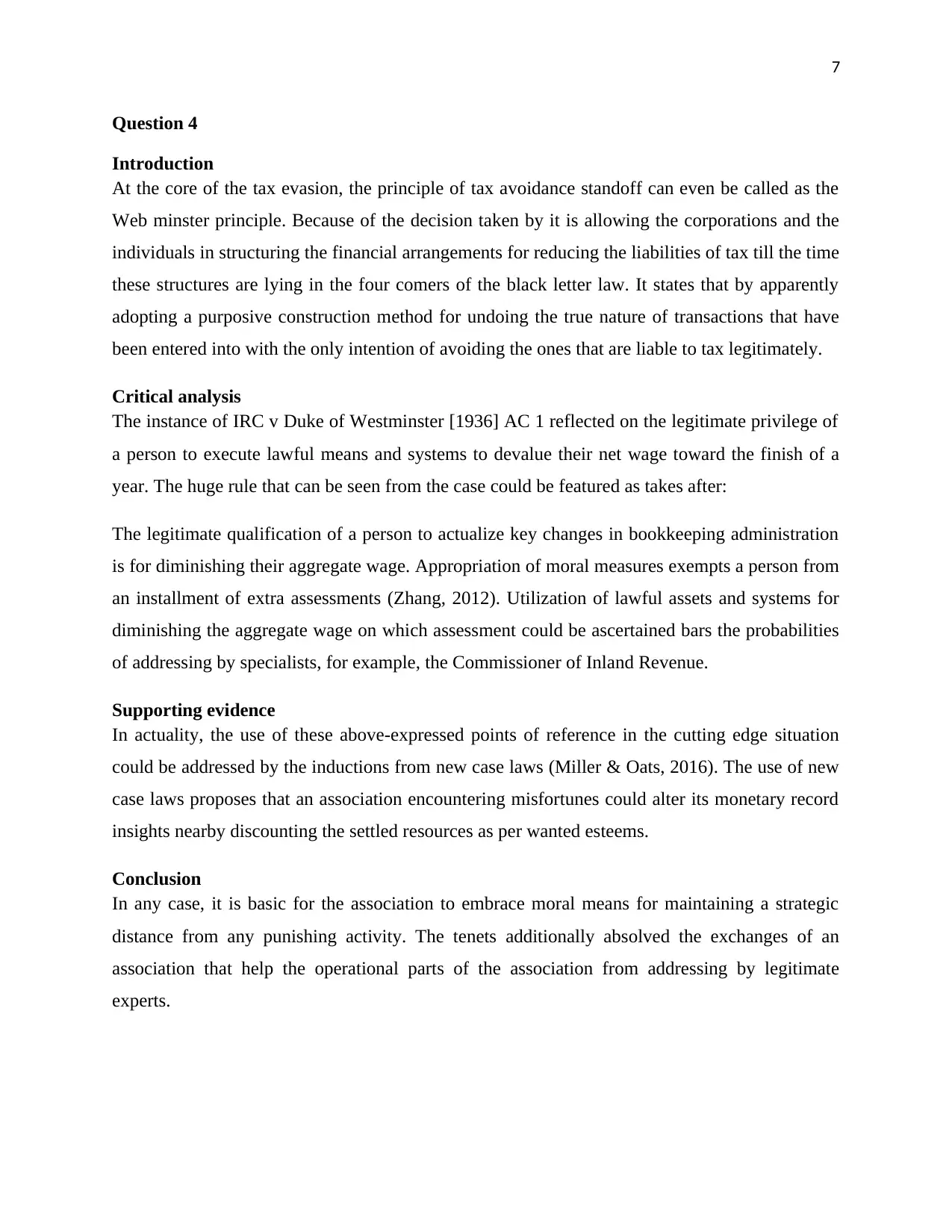
7
Question 4
Introduction
At the core of the tax evasion, the principle of tax avoidance standoff can even be called as the
Web minster principle. Because of the decision taken by it is allowing the corporations and the
individuals in structuring the financial arrangements for reducing the liabilities of tax till the time
these structures are lying in the four comers of the black letter law. It states that by apparently
adopting a purposive construction method for undoing the true nature of transactions that have
been entered into with the only intention of avoiding the ones that are liable to tax legitimately.
Critical analysis
The instance of IRC v Duke of Westminster [1936] AC 1 reflected on the legitimate privilege of
a person to execute lawful means and systems to devalue their net wage toward the finish of a
year. The huge rule that can be seen from the case could be featured as takes after:
The legitimate qualification of a person to actualize key changes in bookkeeping administration
is for diminishing their aggregate wage. Appropriation of moral measures exempts a person from
an installment of extra assessments (Zhang, 2012). Utilization of lawful assets and systems for
diminishing the aggregate wage on which assessment could be ascertained bars the probabilities
of addressing by specialists, for example, the Commissioner of Inland Revenue.
Supporting evidence
In actuality, the use of these above-expressed points of reference in the cutting edge situation
could be addressed by the inductions from new case laws (Miller & Oats, 2016). The use of new
case laws proposes that an association encountering misfortunes could alter its monetary record
insights nearby discounting the settled resources as per wanted esteems.
Conclusion
In any case, it is basic for the association to embrace moral means for maintaining a strategic
distance from any punishing activity. The tenets additionally absolved the exchanges of an
association that help the operational parts of the association from addressing by legitimate
experts.
Question 4
Introduction
At the core of the tax evasion, the principle of tax avoidance standoff can even be called as the
Web minster principle. Because of the decision taken by it is allowing the corporations and the
individuals in structuring the financial arrangements for reducing the liabilities of tax till the time
these structures are lying in the four comers of the black letter law. It states that by apparently
adopting a purposive construction method for undoing the true nature of transactions that have
been entered into with the only intention of avoiding the ones that are liable to tax legitimately.
Critical analysis
The instance of IRC v Duke of Westminster [1936] AC 1 reflected on the legitimate privilege of
a person to execute lawful means and systems to devalue their net wage toward the finish of a
year. The huge rule that can be seen from the case could be featured as takes after:
The legitimate qualification of a person to actualize key changes in bookkeeping administration
is for diminishing their aggregate wage. Appropriation of moral measures exempts a person from
an installment of extra assessments (Zhang, 2012). Utilization of lawful assets and systems for
diminishing the aggregate wage on which assessment could be ascertained bars the probabilities
of addressing by specialists, for example, the Commissioner of Inland Revenue.
Supporting evidence
In actuality, the use of these above-expressed points of reference in the cutting edge situation
could be addressed by the inductions from new case laws (Miller & Oats, 2016). The use of new
case laws proposes that an association encountering misfortunes could alter its monetary record
insights nearby discounting the settled resources as per wanted esteems.
Conclusion
In any case, it is basic for the association to embrace moral means for maintaining a strategic
distance from any punishing activity. The tenets additionally absolved the exchanges of an
association that help the operational parts of the association from addressing by legitimate
experts.
Paraphrase This Document
Need a fresh take? Get an instant paraphrase of this document with our AI Paraphraser
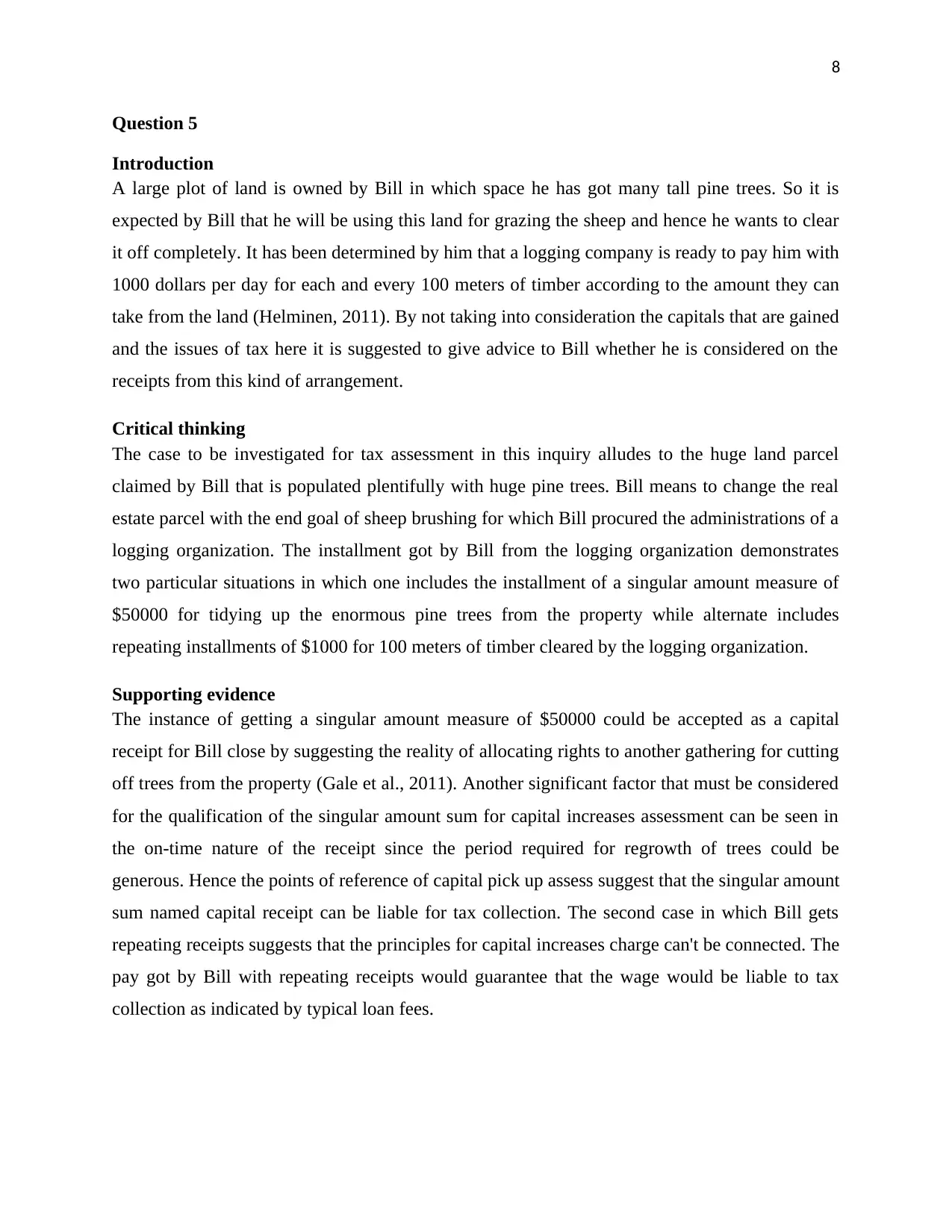
8
Question 5
Introduction
A large plot of land is owned by Bill in which space he has got many tall pine trees. So it is
expected by Bill that he will be using this land for grazing the sheep and hence he wants to clear
it off completely. It has been determined by him that a logging company is ready to pay him with
1000 dollars per day for each and every 100 meters of timber according to the amount they can
take from the land (Helminen, 2011). By not taking into consideration the capitals that are gained
and the issues of tax here it is suggested to give advice to Bill whether he is considered on the
receipts from this kind of arrangement.
Critical thinking
The case to be investigated for tax assessment in this inquiry alludes to the huge land parcel
claimed by Bill that is populated plentifully with huge pine trees. Bill means to change the real
estate parcel with the end goal of sheep brushing for which Bill procured the administrations of a
logging organization. The installment got by Bill from the logging organization demonstrates
two particular situations in which one includes the installment of a singular amount measure of
$50000 for tidying up the enormous pine trees from the property while alternate includes
repeating installments of $1000 for 100 meters of timber cleared by the logging organization.
Supporting evidence
The instance of getting a singular amount measure of $50000 could be accepted as a capital
receipt for Bill close by suggesting the reality of allocating rights to another gathering for cutting
off trees from the property (Gale et al., 2011). Another significant factor that must be considered
for the qualification of the singular amount sum for capital increases assessment can be seen in
the on-time nature of the receipt since the period required for regrowth of trees could be
generous. Hence the points of reference of capital pick up assess suggest that the singular amount
sum named capital receipt can be liable for tax collection. The second case in which Bill gets
repeating receipts suggests that the principles for capital increases charge can't be connected. The
pay got by Bill with repeating receipts would guarantee that the wage would be liable to tax
collection as indicated by typical loan fees.
Question 5
Introduction
A large plot of land is owned by Bill in which space he has got many tall pine trees. So it is
expected by Bill that he will be using this land for grazing the sheep and hence he wants to clear
it off completely. It has been determined by him that a logging company is ready to pay him with
1000 dollars per day for each and every 100 meters of timber according to the amount they can
take from the land (Helminen, 2011). By not taking into consideration the capitals that are gained
and the issues of tax here it is suggested to give advice to Bill whether he is considered on the
receipts from this kind of arrangement.
Critical thinking
The case to be investigated for tax assessment in this inquiry alludes to the huge land parcel
claimed by Bill that is populated plentifully with huge pine trees. Bill means to change the real
estate parcel with the end goal of sheep brushing for which Bill procured the administrations of a
logging organization. The installment got by Bill from the logging organization demonstrates
two particular situations in which one includes the installment of a singular amount measure of
$50000 for tidying up the enormous pine trees from the property while alternate includes
repeating installments of $1000 for 100 meters of timber cleared by the logging organization.
Supporting evidence
The instance of getting a singular amount measure of $50000 could be accepted as a capital
receipt for Bill close by suggesting the reality of allocating rights to another gathering for cutting
off trees from the property (Gale et al., 2011). Another significant factor that must be considered
for the qualification of the singular amount sum for capital increases assessment can be seen in
the on-time nature of the receipt since the period required for regrowth of trees could be
generous. Hence the points of reference of capital pick up assess suggest that the singular amount
sum named capital receipt can be liable for tax collection. The second case in which Bill gets
repeating receipts suggests that the principles for capital increases charge can't be connected. The
pay got by Bill with repeating receipts would guarantee that the wage would be liable to tax
collection as indicated by typical loan fees.
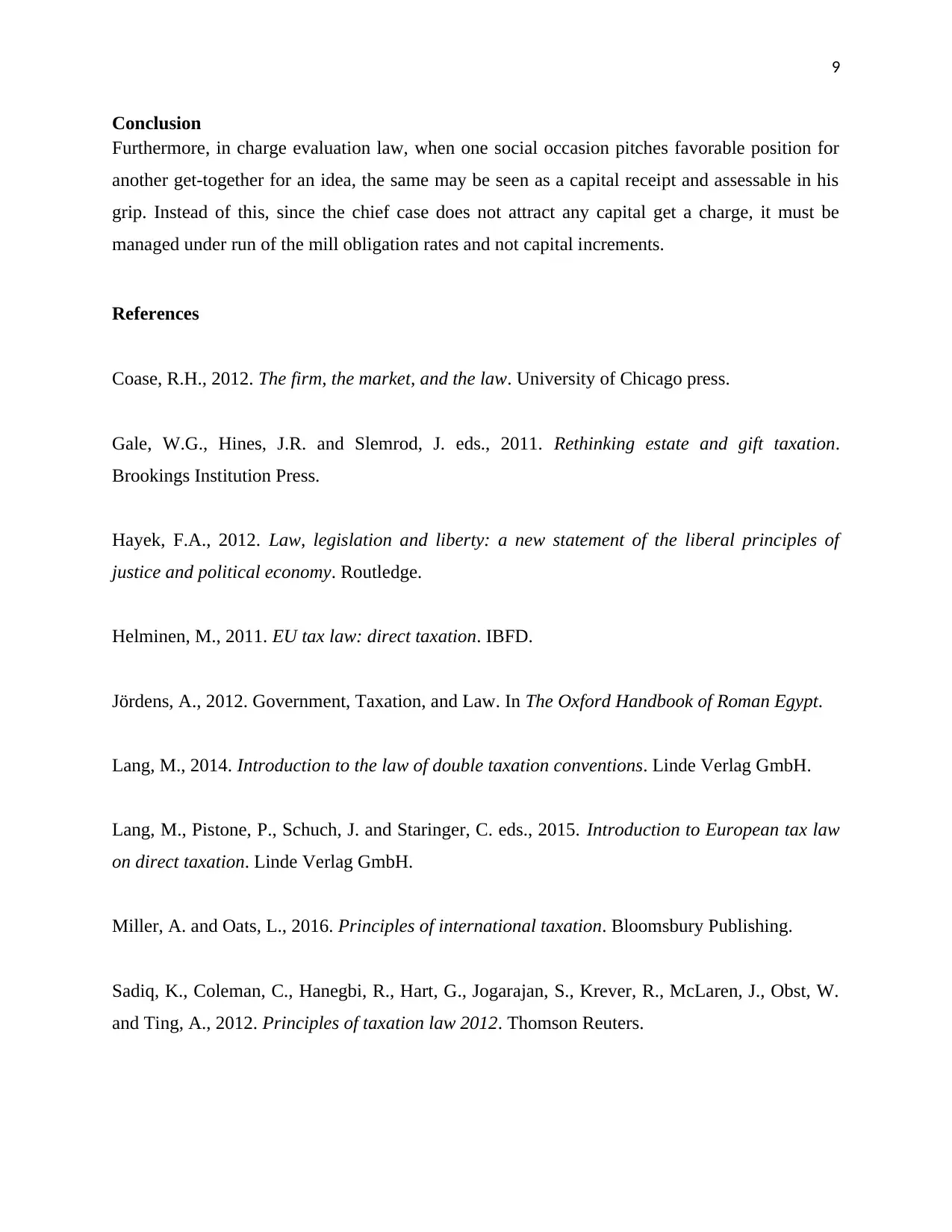
9
Conclusion
Furthermore, in charge evaluation law, when one social occasion pitches favorable position for
another get-together for an idea, the same may be seen as a capital receipt and assessable in his
grip. Instead of this, since the chief case does not attract any capital get a charge, it must be
managed under run of the mill obligation rates and not capital increments.
References
Coase, R.H., 2012. The firm, the market, and the law. University of Chicago press.
Gale, W.G., Hines, J.R. and Slemrod, J. eds., 2011. Rethinking estate and gift taxation.
Brookings Institution Press.
Hayek, F.A., 2012. Law, legislation and liberty: a new statement of the liberal principles of
justice and political economy. Routledge.
Helminen, M., 2011. EU tax law: direct taxation. IBFD.
Jördens, A., 2012. Government, Taxation, and Law. In The Oxford Handbook of Roman Egypt.
Lang, M., 2014. Introduction to the law of double taxation conventions. Linde Verlag GmbH.
Lang, M., Pistone, P., Schuch, J. and Staringer, C. eds., 2015. Introduction to European tax law
on direct taxation. Linde Verlag GmbH.
Miller, A. and Oats, L., 2016. Principles of international taxation. Bloomsbury Publishing.
Sadiq, K., Coleman, C., Hanegbi, R., Hart, G., Jogarajan, S., Krever, R., McLaren, J., Obst, W.
and Ting, A., 2012. Principles of taxation law 2012. Thomson Reuters.
Conclusion
Furthermore, in charge evaluation law, when one social occasion pitches favorable position for
another get-together for an idea, the same may be seen as a capital receipt and assessable in his
grip. Instead of this, since the chief case does not attract any capital get a charge, it must be
managed under run of the mill obligation rates and not capital increments.
References
Coase, R.H., 2012. The firm, the market, and the law. University of Chicago press.
Gale, W.G., Hines, J.R. and Slemrod, J. eds., 2011. Rethinking estate and gift taxation.
Brookings Institution Press.
Hayek, F.A., 2012. Law, legislation and liberty: a new statement of the liberal principles of
justice and political economy. Routledge.
Helminen, M., 2011. EU tax law: direct taxation. IBFD.
Jördens, A., 2012. Government, Taxation, and Law. In The Oxford Handbook of Roman Egypt.
Lang, M., 2014. Introduction to the law of double taxation conventions. Linde Verlag GmbH.
Lang, M., Pistone, P., Schuch, J. and Staringer, C. eds., 2015. Introduction to European tax law
on direct taxation. Linde Verlag GmbH.
Miller, A. and Oats, L., 2016. Principles of international taxation. Bloomsbury Publishing.
Sadiq, K., Coleman, C., Hanegbi, R., Hart, G., Jogarajan, S., Krever, R., McLaren, J., Obst, W.
and Ting, A., 2012. Principles of taxation law 2012. Thomson Reuters.
⊘ This is a preview!⊘
Do you want full access?
Subscribe today to unlock all pages.

Trusted by 1+ million students worldwide

10
Woellner, R., Barkoczy, S., Murphy, S., Evans, C. and Pinto, D., 2011. Australian Taxation Law
Select: legislation and commentary. CCH Australia.
Zhang, S.W., 2012. Theories of taxation law.
Woellner, R., Barkoczy, S., Murphy, S., Evans, C. and Pinto, D., 2011. Australian Taxation Law
Select: legislation and commentary. CCH Australia.
Zhang, S.W., 2012. Theories of taxation law.
1 out of 10
Related Documents
Your All-in-One AI-Powered Toolkit for Academic Success.
+13062052269
info@desklib.com
Available 24*7 on WhatsApp / Email
![[object Object]](/_next/static/media/star-bottom.7253800d.svg)
Unlock your academic potential
Copyright © 2020–2025 A2Z Services. All Rights Reserved. Developed and managed by ZUCOL.





